The word “Dressage” derives from France and is translated to mean “Training”. A well-known sport and art form within the Equestrian industry, Dressage displays and demonstrates the discipline and connection between riders and horses in a harmonious, and elegant manner. The purpose of dressage is to make the movements and riding of the horse look effortless, when most of us know the effort that is required to ride and perform each movement.
There are many dressage specific movements and wording used to describe them which can all get very confusing, even for those who have been doing it for some time and are moving up the levels. In this article, we have decoded them into simple terms and explanations.
Working with the Paces
Within each gait you can be asked to perform these as a working gait, extended, collected or medium – so what is the difference and what adjustability do you need to achieve them?
Working
Used in lower level tests, the working gait should demonstrate regularity and quality of gait. The horse should be properly balanced and remain on the contact while going forward with regular, elastic and cadenced strides.
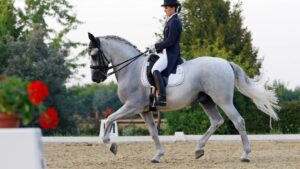
Medium
Medium paces are looking for the beginnings of a lengthening of the frame and stride while maintaining engagement, elasticity, suspension, and uphill balance. This is the ‘in between’ of the working and extended gaits where the horse lengthens the stride a little while still in the same tempo, and rounds more through the back than in the working trot.
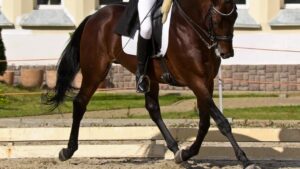
Extended
This is more than just a lengthen of the gait, but requires the legs to stretch further, the body should be elongated without hollowing, and the tempo should not change. You essentially are asking for the same rhythm in your trot, just with more ground cover with each stride.
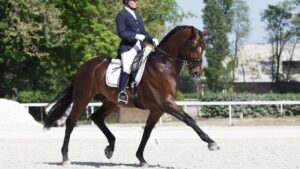
Collected
The tempo again should not change for the collected trot but the ground cover is less and the horses back should be higher, their core engaged and hind legs stepping well under with a more loaded hock. In a dressage test, judges will be looking for engagement, uphill balance and quality of the pace. Many people relate a collected gait to collection (ie contact) when in fact it is the shortening of the back and shorter length of stride, which is achieved when the horse rounds their back, engages their belly, load their hocks and lowers their croup (the beginnings required for piaffe and passage).
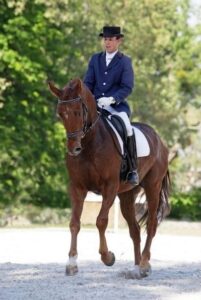
Free or Stretch forward
Another worth noting here is the free walk and the stretch trot which is asked for in dressage tests. No matter which pace you are riding, the free or stretch should show good energy, consistency in rhythm, balance, control and contact.
The free walk should show an overtrack (when hind hoof surpasses the print made by the front hoof) and the horse should not just have stretch across the neck, but have an open gullet.
A stretchy trot is usually one we all like to miss because it is tricky to ride! The stretch trot is not about riding long and low, as this will tend to put the horse on the forehand, but you are looking to achieve more of an arc shape across the whole horse. The neck goes up, out then down, the back is rounded and the horse is still engaging the hind end and is on your aids.
Counter Canter
The horse will canter on the outside leg lead in a regular three beat canter.
Flying Change
The horse will change it’s lead while remaining in canter. The gait should not be interrupted.
Time Changes – 3, 2, 1
An extension on the simple flying change, time or tempi changes are the riding of a number of flying changes in a row with the number of caner strides in-between. Three time changes are those performed every 3 canter strides, two time changes are performed every 2 canter strides and one time changes are performed on every stride, giving the horse the illusion of ‘skipping.’
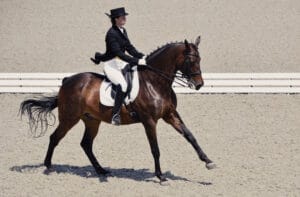
Rein Back
As simple as it sounds, a rein-back is a two beat movement when a horse is asked to back up. The horse should move back straight, without falling to either side, and finish square.
Halt
Simple in concept, sounds easy, hard to ride! You must always ensure the horse does not hollow or flatten the back and the shoulders or haunches do not swing off the line.
The Basic Laterals
Some of the most used lateral movements are Leg Yield and Shoulder-In. How do you perform each correctly?
Leg Yield
The Leg Yield is a lateral movement of which requires the horse to travel both forward and sidewards simultaneously and is the most commonly first-taught Dressage movement introduced to young horses and also encourages horses to respond to leg aids.
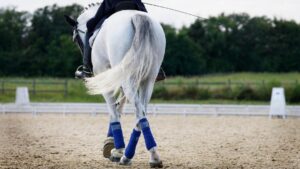
Shoulder In
The shoulder in is a movement performed on three track where the shoulder is brought off the track to the inside and both forelegs follow the same track, while the hind ends stays on the track.
Performing a Shoulder-In movement should consist of the horse’s shoulders and forelegs moving to the inside track, whilst the hind legs remain on the outside of the track with the body bent around the rider’s inside leg. This movement also encourages the horse’s hind leg to swing under the horse itself, which is known to increase hind leg engagement. Supporting the outside reins assists in maintaining the horses Shoulder-In angle, reducing the chances of the outside shoulder slipping out.
Turn on the forehand
Turn on the forehand requires the horse to move its hindquarters around its front legs as it executes a 180-degree turn, starting and ending in halt.
Turn on the Hind/Haunches
Turn on the hind requires the horse, while bent in the direction of the turn, to move its forehand around its hindquarters 180 degrees. This is the beginning of training pirouettes.
The Half-Pass, Travers, and Renvers Movements
Half Pass
The half pass is where the horse will be moving both forward and sideways on a line of travel. You can also use half pass on a circle, or to return to the track after completing a movement.
Another way to think of the half pass is as travers on a diagonal line.
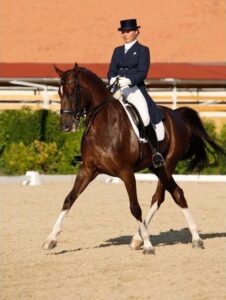
Travers
In Travers the horse travels with its haunches in. The horse will move with the forehand following the track and the hindquarters leaving the track, bending in the direction of the line of travel. You must remember to keep the horse forehand moving straight down the track.
Renvers
Renvers is similar to Travers, although the way of which the rider moves the horses body based on their position within the arena is what differs the two movements. In renvers the horse’s haunches should be in towards the wall with the shoulders shifted out. The hindquarters walk along the track along the wall, with the shoulders on the inside track.
Advanced Laterals
Volte
The volte is a 6, 8 or 10-meter circle which starts and ends at the same point. It is used as a suppling and strengthening exercise and makes an appearance at Prix St-Georges level. It requires the most balance from a horse and is the building blocks to move towards pirouettes.
The Pirouette
The Pirouette is a two-tack lateral movement common in Dressage in which the equine is required to spin in a circle with the hind creating a smaller circle than the front, with the front legs and the outer hind leg travelling around the inside hind leg, usually performed at a canter; when performed at a walk this movement is more commonly referred to as the turn on the haunches movement. The name Pirouette derives from the French word known best in Ballet, which means “to whirl about” and performing this movement requires a high level or training from both the rider and equine. A Pirouette can be performed as a 360 degree turn, known as the Full-Pirouette; a 270 degree turn, known as the Three-Quarter Pirouette; or as a 180 degree turn, known as the Half-Pirouette. When performing this Dressage movement at a walk the equines strides should consist of four beats, although when performed at a canter the stride beat decreases to three with suspended movement.
Passage & The Piaffe Movements Explained
The most well know Grand Prix Dressage trot movements are: The Piaffe and The Passage.
Passage
Described as the ‘very elevated trot with wow-factor, the Passage is an upper-level movement in which a collected trot is measured, very collected and elevated, with the diagonal feet being raised and lowered alternatively, exercising cadence. Known best for the pronounced engagement of the hind quarters, as well as flexion of the knees and hocks, delivering smooth, graceful movements with prolonged suspension of the feet raising and returning. The Passage requires a high level of equine training and collecting and is regarded as a strenuous movement.
Piaffe
The Piaffe in its simplest explanation is the ‘elevated trot on the spot. It is an advanced trot known for its cadence, elevation, and precision of placement, with similarities to The Passage. The Piaffe requires diagonal feet to rise and fall alternatively (with ‘spring’), ensuring the quarters are lowered allowing the engagement of haunches with active hocks, which in turn provides greater freedoms and mobility to the forehand and shoulders. The equine performing this movement should retain an even rhythm displaying calm mannerisms and impulsion.
Fun fact: The Piaffe was first used in battle in an attempt to keep the horses moving, as well as enhancing the horse’s focus and temperature.
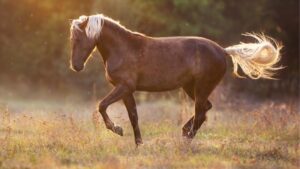
The Rewards of Dressage
With a wide variety of Dressage movements to be performed, there is no doubt riders can practice movements to improve their horses gymnastic skill, flexibility, ability and skill set. When completed correctly Dressage demonstrates the harmony and trust between horse and rider, as well as displaying the time and effort it takes to school obedient movements – an incredibly rewarding sport for both the rider and the horse that can benefit horses and riders of any discipline.



